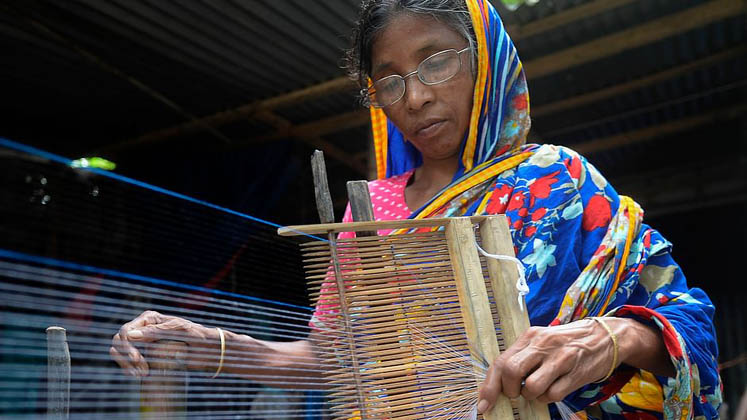
The history of weaving industry in Bangladesh is very old and equally rich! From time immemorial, the art of weaving has brought Bengal to the world even as the weaving industry has also been playing a very important role in the economy of the country, which in terms of rural employment generation, was said to be next only to agriculture.
The nation’s centuries-old traditional weaving was once highly sought after, with nobility from Asia and Europe wearing the fine muslin clothing even as some reports suggest that weavers of the AdiBasak community were the original weavers of the Indian subcontinent. Initially they came from the Indus Basin to Murshidabad in West Bengal and started weaving, only to spread out later to different parts of Rajshahi, Bajitpur of Kishorganj and Dhamrai of Dhaka.
At present, several regions of Bangladesh such as Narsingdi, Raipura, Demra, Tangail, Shahjadpur, Bera, Kumarkhali, Ruhitpur, Baburhat, Gournadi and Nasirnagar are some of the renowned names in weaving, which is a popular cottage industry in Bangladesh even as according to a 2003 survey by the Bangladesh Bureau of Statistics (BBS), the number of handlooms in the country was around five lakhs of which near about two lakh handlooms are closed, while according to some estimates, there are roughly nine lakh weavers in the country.
But over the past two decades, Bangladesh has made rapid progress in the realm of readymade garment manufacturing and exports to become the second largest apparel exporter globally, after China and catering to almost all the big names from across geographical locations. However, as the country is attaining greater success in the realm of apparel manufacturing, it left in its wake the traditional weavers, whose numbers are dwindling by the day.
With respect to the same, Manirampur in the Jessore district comes to one’s mind as they are reportedly fighting a losing battle for their existence while also trying to keep their craft alive.
Situated on the bank of Harihar River, Manirampur Upazila of Jessore district in the division of Khulna, is bounded by Jessore Sadar Upazila on the north, Kalaroa and Jhikargachha upazilas on the west, Abhaynagar Upazila on the east and Dumuria and Keshabpur upazilas on the south.
According to reports, Manirampur has been a popular hub for handloom industry with around 80,000 handloom workers living in 78 villages of its 249 villages, many of whom are from the villages of Bharatpur, Paralo and Muzgunni villages. However, with time, the number of Pitloom and Khatkhati (traditional loom equipment) are dwindling rapidly even as a weaver of Paralo village claimed that he had once 60 to 70 Pitlooms and Khatkhatis in his house, which has now come down to only 22 pitlooms.
Also Read: COVID-19: Workers at the receiving end, thanks to ‘wage theft’ and wage gap!
Similarly, the number of people, who are engaged in weaving for livelihood are also dwindling fast as most of them reportedly leave this profession thereby putting the famous weaving industry of Manirumpur to serious threat of extinction, thanks to labour scarcity, lack of raw materials and other challenges.
“Weavers no longer can earn their living through this profession,” claimed a weaver named Abdur Rauf speaking to the media, who underlined that a weaver gets around Taka 40 as wage for weaving a two-yard towel or gamcha even as after working for the whole day almost, a weaver manages to make only around Taka 150 to Taka 200, which falls drastically short in meeting the requirements of a family.
That is why they are quitting this profession, said Abdur even as other weavers of Manirumpur concede that they are losing in the competition from their counterparts in Kushtia, Sirajganj and Pabna.
Our competitors have developed the industry with modern technology, said Abdur but only to underline that it has made things way more difficult for traditional handlooms even as loom owners are now reportedly urging the Government to help and support them to save this dying traditional craft as they believe that with necessary raw materials, modern equipment, training and easy-term low interest loans, this cottage industry can be rejuvenated again.
Meanwhile, speaking to the media, Central Secretary for Education and Human Resources of Bangladesh Weavers League, Professor Mohammad Babul Akhter, mentioned that in order to keep the weaving community and the weaving industry alive in Monirampur, it was necessary to provide modern training to the workers, modern equipment and easy loans to this community.
If the Government is sincere in this regard, the people of the weaving community will be able to survive, claimed Professor Akhter.
Similar is the story of Mominnagar in Jessore, which was once famous for making a variety of garments like sarees, lungi, towel, but is staring at extinction, as per some reports, which underlined the main feature of the garments produced here is the long-lasting colour, which does not fade quickly as a special process is followed before the cotton/thread is used.
First the thread is bought, washed and immersed in two chemicals; then the thread is boiled in hot water mixed with hydro-caustic and in the end, the dried thread is used for weaving even as in the 1940s, an association was formed to safeguard the interests of the weavers.
There were reportedly around 35 weaving machines in operation in the ’80s which came down to around 8 in 2017 and all the machines are shut now.
“If the Government provides support, then we will return to the profession of our forefathers,” reportedly maintained a weaver while interacting with the media earlier, adding, “In the 1990s, printed Indian sarees started coming and since those were sold at cheaper rates, our industry took the battering.”
An Indian item is reportedly sold for around Taka 200 whereas that made here costs around Taka 300, claimed the weaver even as people in know of things underlined that failing to keep up with competition from cheap imports, weavers who earned around Taka 100 to Taka 150 are now moving to other professions even as many former weavers are now working as masons and since the earning is much higher, they are reluctant to go back to their previous profession of weaving.
“I have been working as a weaver since 1964 but unemployed now,” said Alfazuddin, once known as weaving master even as the then General Secretary of Momennagar Cooperative Union, Golam Mostafa, on his part maintained: “Government intervention is needed to revive the moribund industry; in addition, easy loans, training, subsidy and proper market management can revitalise the almost extinct weaving industry.”
Going by the developments, the famed weaving sector of Jessore runs high risk of getting extinct until and unless it gets the much-needed help and support.
However, in an unrelated but positive development, the lost muslin yarn technology used to churn out exceedingly delicate fabrics, much coveted in the 17th and 18th centuries the world over, has now been recovered by an expert team of the Government, as per reports even as a Taka 12.1 crore project was initiated after Prime Minister Sheikh Hasina during a visit to the Ministry of Textiles and Jute 2014 enquired if the lost technology of muslin could be restored, subsequent to which a committee was formed consisting of experts from the Bangladesh Handloom Board (BHB), the Bangladesh Textile Mills Corporation, the Cotton Development Board, the Bangladesh University of Textiles, Dhaka University and Rajshahi University.
Given this positive development, all one can hope is stakeholders, including the Government put in the efforts to try save the centuries-old traditional weaving sector before it become a case of too little too late.






